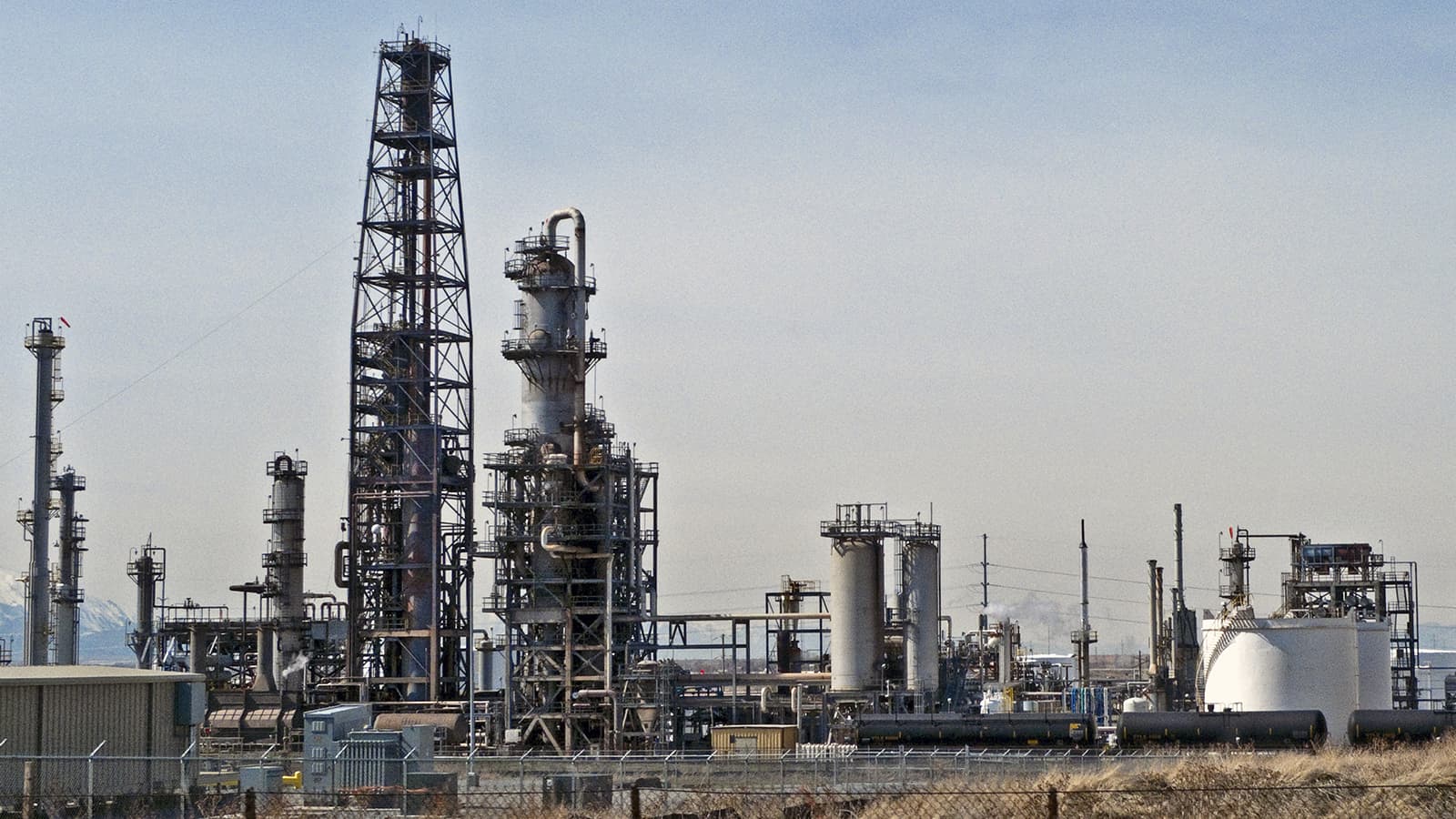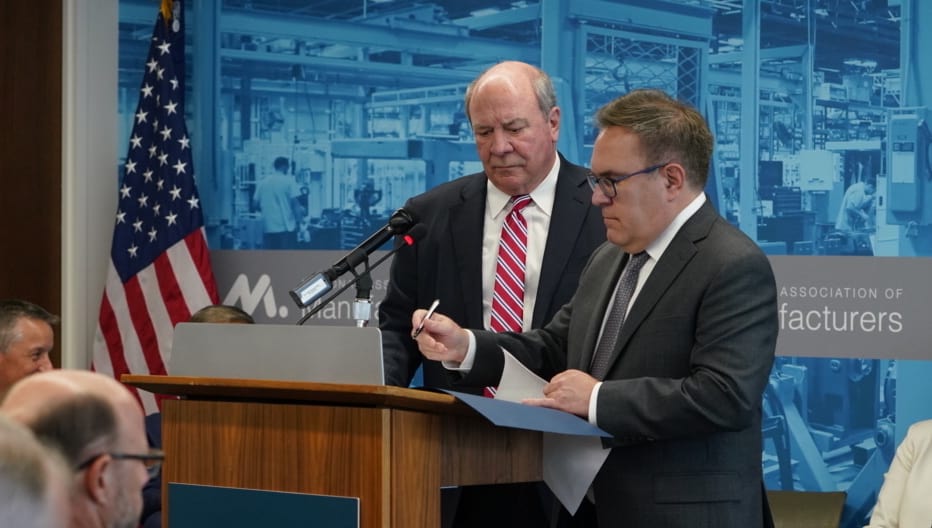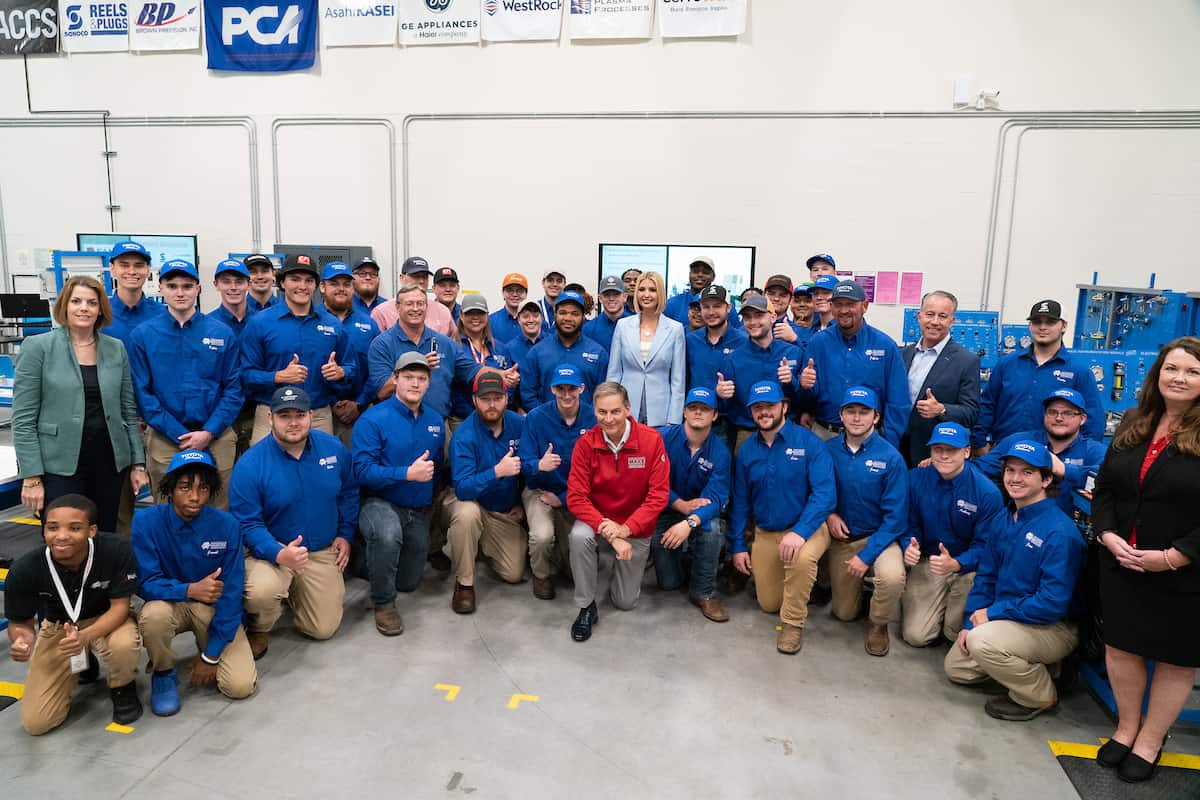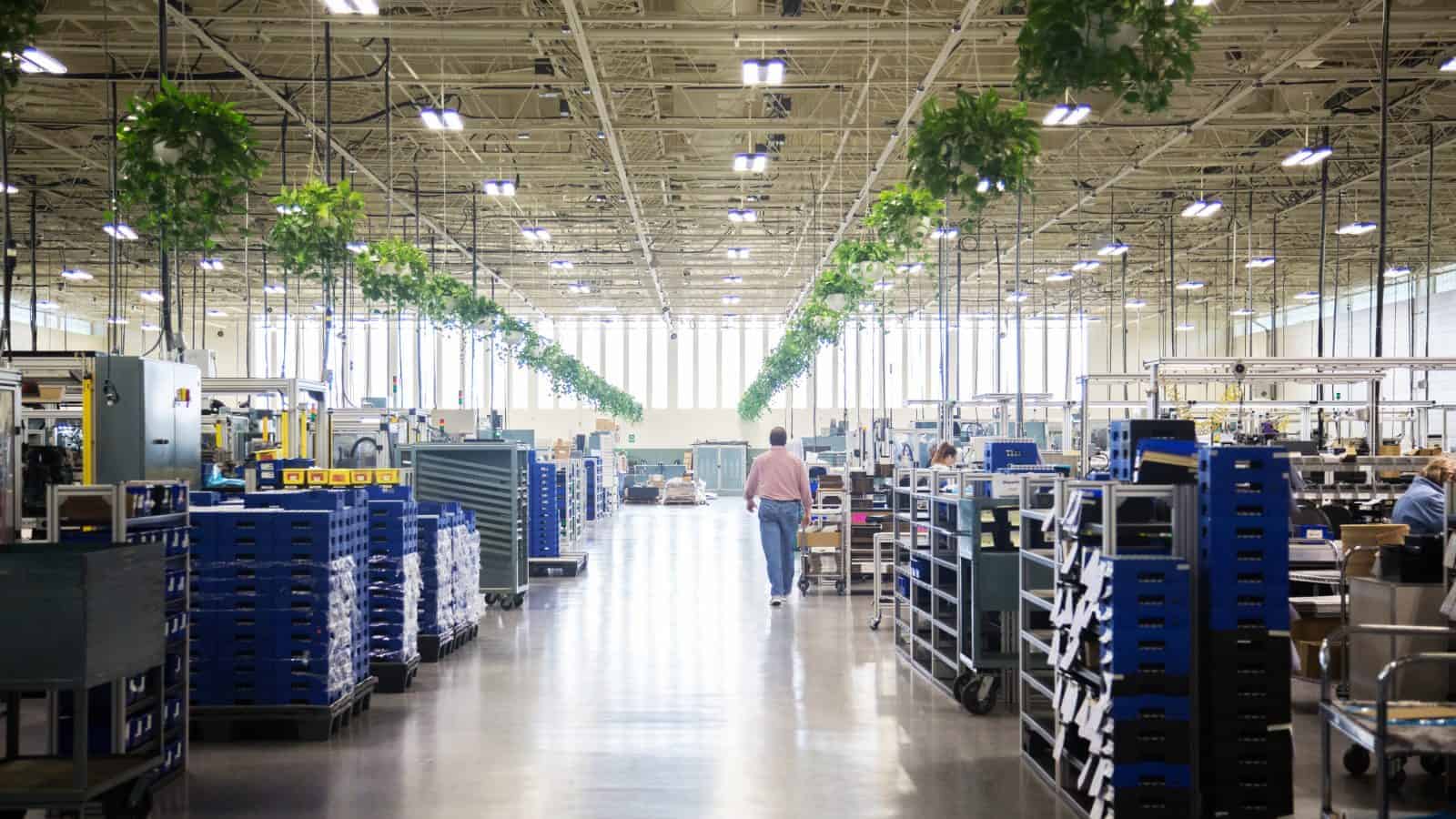Researchers Discover New Method of Carbon Capture

Scrubbing CO2 out of natural gas power plant emissions just got easier, due to a breakthrough from scientists at the University of California, Berkeley, Lawrence Berkeley National Laboratory and ExxonMobil.
The bottom line: The new technology is six times more effective at removing CO2 than current technologies . . . hitting an impressive 90% capture rate, according to a writeup in Gas World.
How it works: “The new technique uses a highly porous material called a metal-organic framework (MOF), modified with nitrogen-containing amine molecules to capture the CO2 and low temperature steam to flush out the CO2 for other uses or to sequester it underground.”
But remember, it takes federal policies to support this kind of wholesale carbon capture. And speaking of which . . .
Sneak peek: The NAM is working on a raft of climate recommendations, which it will release later this year. Here’s a preview of what the report will recommend on carbon capture. Lawmakers should:
- “Finish clarifying the rules governing access to the Section 45Q carbon capture tax credit so that project developers have the certainty they need to make investments in CCUS projects”;
- “Develop a clear standard for the handling of long-term liability for CO2 transfers”;
- “Resolve pore space ownership issues”;
- “Correct barriers to CO2 storage on federal lands”;
- “Reform the class VI underground injection program to foster the build-out of underground CO2 storage projects”;
- “Increase funding for federal CCUS research, development and demonstration programs”; and
- “Ensure programs are authorized and reduce permitting barriers that delay construction of CCUS projects.”
Manufacturers Back Ambitious CO2 Standards for Aerospace Sector
EPA proposal strengthens the aviation industry against international competitors
Washington, D.C. – Following the EPA’s emissions standard proposal for airplanes to align U.S. standards with those set by the International Civilian Aviation Organization, NAM’s Vice President of Energy & Resources Policy Rachel Jones released the following statement:
Manufacturers are committed to smart, strong environmental protections, improving the lives of all Americans. The newest airliners are as fuel efficient as a hybrid electric car, all while making trips of a lifetime possible, and we are on the cutting edge of next-generation technologies. Modern aircraft are 80% more carbon efficient than the first airliners, and a flight today has half the carbon-footprint of the same flight in 1990. That’s why that the NAM has been pushing the EPA to set ambitious CO2 standards for the aerospace sector, to strengthen the aviation industry against international competitors, propel our economic renewal and continue leading the world in carbon reductions. We support the EPA’s proposal to set standards in line with international standards that will put the American aerospace sector in a position to continue leading on a global stage.
-NAM-
The National Association of Manufacturers is the largest manufacturing association in the United States, representing small and large manufacturers in every industrial sector and in all 50 states. Manufacturing employs more than 11.7 million men and women, contributes $2.37 trillion to the U.S. economy annually and has the largest economic multiplier of any major sector and accounts for 63% of private-sector research and development. The NAM is the powerful voice of the manufacturing community and the leading advocate for a policy agenda that helps manufacturers compete in the global economy and create jobs across the United States. For more information about the NAM or to follow us on Twitter and Facebook, please visit www.nam.org.
NAM Applauds Stronger Environmental Reviews
CEQ’s bold steps set the stage to incentivize job creation and investment in America
Washington, D.C. – Today, as the Council on Environmental Quality (CEQ) announced updates to modernize procedural provisions of the National Environmental Policy Act (NEPA) and increase local and tribal input, National Association of Manufacturers Vice President of Energy & Resources Policy Rachel Jones released the following statement:
“Manufacturers are committed to smart, strong environmental protections, improving the lives of all Americans and building a more inclusive future together. Amid the COVID-19 pandemic it is more important than ever to strengthen U.S. manufacturing capabilities and operations. Onshoring manufacturing requires first establishing basic infrastructure—from water and energy delivery to transportation—before ground can ever be broken on a major facility. Obtaining permits for these items can take years, especially when environmental reviews are piecemeal, but CEQ’s bold steps today utilize existing authority to strengthen reviews, reduce the time necessary to obtain permits and set the stage to incentivize job creation and investment in America.”
-NAM-
The National Association of Manufacturers is the largest manufacturing association in the United States, representing small and large manufacturers in every industrial sector and in all 50 states. Manufacturing employs more than 11.7 million men and women, contributes $2.37 trillion to the U.S. economy annually and has the largest economic multiplier of any major sector and accounts for 63% of private-sector research and development. The NAM is the powerful voice of the manufacturing community and the leading advocate for a policy agenda that helps manufacturers compete in the global economy and create jobs across the United States. For more information about the NAM or to follow us on Twitter and Facebook, please visit www.nam.org.
Timmons Delivers 2020 NAM State of Manufacturing Address in Iowa
Speech Marked 125th Anniversary of NAM’s Founding and Highlighted ‘Creators Wanted’ Campaign to Address Growing Workforce Shortage
Washington, D.C. – National Association of Manufacturers President and CEO Jay Timmons delivered the eighth-annual NAM State of Manufacturing Address today at equipment manufacturer Vermeer Corporation in Pella, Iowa. Speaking to Vermeer Corporation employees, business and community leaders and local manufacturers, Timmons highlighted the NAM’s ambitious plan to address the industry’s growing workforce crisis with the groundbreaking, multimillion-dollar “Creators Wanted” campaign.
In his remarks, Timmons said:
“For 125 years, your NAM has led the business community and fought for all who make things in America. And all of you in this room, and the 13 million men and women in our industry, some of whom are watching today, are part of the storied history of building an exceptional nation. And Vermeer, this very company, embodies the story of manufacturers’ progress.”
. . . .
“In this pivotal year, the NAM and The Manufacturing Institute, our workforce and education partner, are setting out on an unprecedented campaign to inspire a new generation—and tell the real story of our industry. . . . Our historic effort, called “Creators Wanted,” is a capital campaign that will support the programs of the Manufacturing Institute—including the STEP Women’s Initiative, youth engagement and Heroes MAKE America, which trains our returning servicemembers for high-paying manufacturing jobs.”
. . . .
“Just yesterday, in his remarks at the World Economic Forum, President Trump touted manufacturing’s growth and success during his presidency. As I’ve said before, from tax reform to regulatory certainty to leveling the playing field, promises made to manufacturers have been promises kept—and the employment and output numbers show it.”
. . . .
“Here’s what I will say about this election . . . It’s not the label next to a candidate’s name—whether an “R,” a “D” or an “I”—that determines whether he or she will be a good president or even a good member of Congress. The test is whether he or she will work to uphold the values that make America exceptional. These are the same four values, the same four pillars, that make our industry’s success possible.”
Timmons also noted the generous contributions made by Vermeer and Pella Corporation to the NAM’s Creators Wanted campaign.
“And I am proud to announce today that Vermeer Corporation, along with your foundation and Mary and Dr. Dale Andringa, have contributed $100,000 to this cause. And another local manufacturer, Pella Corporation, is also leading by example with a $100,000 contribution of their own,” said Timmons.
Vermeer Corporation President and CEO Jason Andringa thanked Timmons for his visit and the NAM’s commitment to ensuring the long-term success of manufacturing in the United States.
“Thank you to Jay Timmons and the National Association of Manufacturers for visiting Vermeer Corporation and recognizing the incredible work of our team members and manufacturers across the country,” said Andringa. “These men and women truly demonstrate the impact our industry makes every day and represent the success of American manufacturing.”
To read the full address, click here.
-NAM-
The National Association of Manufacturers is the largest manufacturing association in the United States, representing small and large manufacturers in every industrial sector and in all 50 states. Manufacturing employs more than 12.8 million men and women, contributes $2.37 trillion to the U.S. economy annually and has the largest economic multiplier of any major sector and accounts for 63% of private-sector research and development. The NAM is the powerful voice of the manufacturing community and the leading advocate for a policy agenda that helps manufacturers compete in the global economy and create jobs across the United States. For more information about the Manufacturers or to follow us on Twitter and Facebook, please visit www.nam.org.
NAM Joins POTUS at NEPA Event
Washington, D.C. – National Association of Manufacturers President and CEO Jay Timmons released the following statement after joining President Donald Trump at the White House as he announced proposed updates to the National Environmental Policy Act implementing regulations.
President Trump is once again taking action to power our industry—and our economy—forward. The NAM’s Building to Win infrastructure plan called for exactly this type of modernization—because our efforts should be used for building the infrastructure Americans desperately need, not wasted on mountains of paperwork and endless delays.
We thank the administration for listening to manufacturers—and working to ensure that the 21st-century highways, bridges, power lines, cell towers and more that we rely on get built. Our hope is that these improvements will modernize infrastructure permitting so we can get more shovels in the ground and even more manufacturers to work. Manufacturers will continue keeping our promise to reduce our environmental footprint through innovation and sustainable practices—because we know that economic growth and environmental stewardship can and must go hand-in-hand.
-NAM-
The National Association of Manufacturers is the largest manufacturing association in the United States, representing small and large manufacturers in every industrial sector and in all 50 states. Manufacturing employs more than 12.8 million men and women, contributes $2.38 trillion to the U.S. economy annually, has the largest economic multiplier of any major sector and accounts for more than three-quarters of private-sector research and development. The NAM is the powerful voice of the manufacturing community and the leading advocate for a policy agenda that helps manufacturers compete in the global economy and create jobs across the United States. For more information about the Manufacturers or to follow us on Twitter and Facebook, please visit www.nam.org.
What to Expect in 2020 on Legal Issues in Manufacturing

The Manufacturers’ Center for Legal Action is the voice for manufacturers in the courts, fighting to advance policy objectives and advocate for strategic manufacturing interests. National Association of Manufacturers Senior Vice President, General Counsel and Corporate Secretary Linda Kelly leads the MCLA. Here she breaks down manufacturers’ biggest victories in 2019 and what is ahead for 2020.
What were the key legal issues for manufacturers this year?
Manufacturers face all sorts of issues in the courts. And even though only one company’s name may be on a case, the outcome can have profound effects across the entire industry on everything from project permitting to free speech.
This year, we filed amicus—or “friend of the court”—briefs in 74 cases. These address issues like regulatory overreach, product liability, labor and employment law, environmental issues, arbitration, class actions, free speech of manufacturers, ERISA, Alien Tort Statute, tax and international issues. If it matters to manufacturers, we’re on it.
We are also part of a dozen ongoing cases, including ones related to tax incentives, regulatory certainty and the manufacturing workforce. In the environmental space, the NAM has intervened in several cases to protect sensible pro-manufacturing regulatory reforms.
What legal wins did manufacturers accomplish in 2019?
We saw big wins this year invalidating the onerous Waters of the United States rule, preserving energy infrastructure projects, protecting Clean Air Act permitting reforms, securing manufacturers’ rights against government compelled speech, reversing overbroad collective bargaining interpretations by the National Labor Relations Board and more.
What does the invalidation of the 2015 Waters of the United States rule mean for manufacturers?
In two words: clarity and certainty. The 2015 rule was bafflingly unclear and uncertain. It left manufacturers to wonder whether wet areas on their property required a federal permit for any commercial activity there—at the risk of fines of $50,000 per day or more for the “wrong” interpretation. Two federal courts invalidated the rule in response to NAM litigation, which followed a NAM-led win in the U.S. Supreme Court in 2018 that allowed those cases to move forward. Soon thereafter, the EPA formally rescinded the rule.
What legal issues should manufacturers pay attention to in 2020?
Federal agencies will continue their regulatory reform efforts, and groups opposed to those reforms will continue to sue to block them. The MCLA stands ready to intervene in those cases or file briefs to provide the manufacturing perspective to the courts.
We are likely to see appellate court rulings next year interpreting whether making and selling energy products is a “public nuisance” for which companies can be held liable. We are confident the courts will apply the law fairly and reject these groundless lawsuits. But if a court finds in favor of the plaintiffs, we could see the U.S. Supreme Court again weigh in on the scope of public nuisance law.
Plaintiffs’ lawyers will keep trying to twist legal precedent to profit at the expense of manufacturers, and the MCLA will fight them every step of the way to benefit the people who make things in America.
General Mills Digs Into Greenhouse Gas Reduction Efforts

To advance its efforts as a leader in sustainability, General Mills set a goal to reduce absolute greenhouse gas emissions across its full value chain by 28 percent by 2025. To achieve this, the global food company identified three key opportunity areas: implementing sustainable agricultural processes, streamlining production operations and optimizing the consumer experience.
First, the company is addressing sustainability at its roots. General Mills’ work to reduce emissions across their full value chain starts at the farm level. The company works with suppliers and farmers to implement practices like regenerative agriculture, dairy management and reforestation.
Second, it is optimizing production operations—processes like mixing, cooking, toasting, freezing and packaging—that generate the bulk of production-related greenhouse gas emissions. The supply chain team significantly reduced this impact by consolidating some production operations and reducing the average emissions intensity of electricity the company purchased.
Finally, it’s improving the customer experience. On the consumer end, activities like shopping, preparing, eating and disposing of food products also generate greenhouse gas emissions. General Mills’ portfolio has shifted to more products that do not require cooking or refrigeration, which cuts down on related consumption emissions. Recycling was also emphasized on pack.
“The biggest way General Mills can impact climate change is within our supply chain,” said General Mills Chief Supply Chain and Global Business Solutions Officer John Church. “By using our global scale, we work to create value and reduce our footprint for the benefit of consumers, supplier partners, communities and the planet.”
Understanding food waste in landfills creates greenhouse gas emissions, the food company provides philanthropic support to leading nonprofits that make it possible for food companies, grocers, restaurants, distributors, trucking companies and other organizations to donate surplus food so it can be distributed to people in need, while bettering the environment.
“Over the past year, our global investments in food recovery technology with our nonprofit partners have enabled the recovery and redistribution of more than 4 billion pounds of surplus food and our food donations enabled 29 million meals for food-insecure people around the world,” Church said.
“Manufacturers are taking meaningful steps to lead sustainability efforts across the nation,” said Laura Berkey-Ames, NAM’s director of energy and resources policy. “General Mills’ efforts are an excellent example of manufacturers putting sustainability plans into action that make an immediate difference in the lives and communities of their customers.”
Manufacturers to Congress: Act on Climate
In September, the National Association of Manufacturers called on Congress to take action to address climate change. NAM Vice President of Energy and Resources Policy Ross Eisenberg testified before the House Energy & Commerce Committee Subcommittee on Environment & Climate Change and shared what the manufacturing sector is doing to reduce emissions.
Manufacturers are making environmentally conscious improvements because their customers, employees and shareholders have prioritized it — and because it’s the right thing to do, Eisenberg said in his testimony. Over the past decade, manufacturers have reduced the carbon footprint of their products by 21 percent while increasing their value to the economy by 18 percent, according to International Energy Agency data.
The last major congressional debate about how to address climate change was more than a decade ago. To solve this problem, manufacturers must think big, and Eisenberg told the committee that the industry is ready to work with Congress on solutions.
See the highlights from Eisenberg’s testimony below.
EPA Washes Away Controversial Waters Rule

At the National Association of Manufacturers’ headquarters last week, Environmental Protection Agency Administrator Andrew Wheeler, Assistant Secretary of the Army for Civil Works R.D. James and NAM CEO Jay Timmons announced a major victory for manufacturers. The EPA has decided to withdraw the 2015 Waters of the United States (WOTUS) rule that was finalized during the Obama administration.
Manufacturers and others have criticized the rule since 2015, arguing that it was overly broad and went much further than the Clean Water Act allowed. In some cases, the rule—which was supposed to regulate places covered in water—was used to control land that is not wet. Opponents of the rule warned that it threatened manufacturing jobs while failing to adequately protect clean water, and a patchwork of legal challenges created uncertainty across the country and paralysis among the businesses and landowners affected.
“The EPA and the Department of the Army finalized a rule to repeal the previous administration’s overreach in the federal regulation of U.S. waters and recodify the longstanding and familiar regulatory text that previously existed,” said Wheeler. “Last week’s Step 1 action fulfills a key promise of President Trump and sets the stage for Step 2—a new WOTUS definition that will provide greater regulatory certainty for farmers, landowners, homebuilders and developers nationwide.”
“This decision by the EPA clears away a vague and onerous rule that put impossible burdens on manufacturers and other landowners nationwide,” said Ross Eisenberg, Vice President of Energy and Resources Policy at the National Association of Manufacturers. “Americans deserve clean water, and that requires smart water policy that is practical and effective.”
Over the past four years, the NAM submitted multiple sets of comments regarding the 2015 WOTUS rule to better inform policymakers. In addition, the NAM supported President Donald Trump’s 2017 executive order instructing the EPA to rescind the rule, and the NAM’s Manufacturers’ Center for Legal Action has been in active litigation against the rule since July 2015. The legal battle included a unanimous victory for the MCLA at the U.S. Supreme Court on a key procedural issue, and earlier this year federal judges invalidated the rule.
With the 2015 WOTUS rule now rescinded, the NAM is continuing its work to provide policy insight and expertise for a new version of the rule that is consistent with the Clean Water Act and protects American waters while providing certainty for manufacturers and landowners around the country.
“Manufacturers will continue to fight for fair and clear regulations that empower us to be responsible stewards of the environment while growing the U.S. economy,” said Eisenberg. “Our industry represents more than 12.8 million employees in communities across the country, and we are committed to ensuring that the environment in which they live and work is safe, clean and well-protected.”
NAM in 5 Photos: Week of Sept. 9

This week, the National Association of Manufacturers helped move the manufacturing industry forward on three major fronts.
- The NAM’s workforce and education partner, the Manufacturing Institute, announced it will expand Toyota North America’s successful FAME apprenticeship program nationwide. The MI’s Executive Director Carolyn Lee, the NAM’s CEO Jay Timmons, Special Advisor to the President Ivanka Trump, TMNA’s Executive Vice President Chris Nielsen and Ingersoll Rand CEO Michael Lamach shared this news during a roundtable with FAME apprentices.
- At the NAM’s headquarters, Export-Import Bank President and Chairwoman Kimberly Reed participated in a roundtable with manufacturers to discuss the critical bank reauthorization.
- Also at the NAM’s headquarters, Environmental Protection Agency Administrator Andrew Wheeler and Assistant Secretary of the Army for Civil Works R.D. James joined Timmons to announce the finalization of a rule to repeal the controversial 2015 Waters of the United States rule and clear the way for a new rule to protect America’s water resources without overstepping the bounds of the law.
